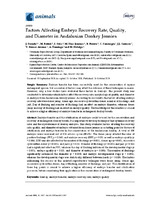Mostrar el registro sencillo del ítem
Factors Affecting Embryo Recovery Rate, Quality, and Diameter in Andalusian Donkey Jennies
| dc.contributor.author | Dorado, Jesús | |
| dc.contributor.author | Bottrel, M. | |
| dc.contributor.author | Ortiz, I. | |
| dc.contributor.author | Díaz-Jiménez, María | |
| dc.contributor.author | Pereira, Blasa | |
| dc.contributor.author | Consuegra, César | |
| dc.contributor.author | Carrasco, J.J. | |
| dc.contributor.author | Gómez-Arrones, V. | |
| dc.contributor.author | Domingo, A. | |
| dc.contributor.author | Hidalgo, Manuel | |
| dc.date.accessioned | 2020-10-26T13:05:36Z | |
| dc.date.available | 2020-10-26T13:05:36Z | |
| dc.date.issued | 2020 | |
| dc.identifier.uri | http://hdl.handle.net/10396/20606 | |
| dc.description.abstract | Embryo transfer and the vitrification of embryos could be used for the conservation and recovery of endangered donkey breeds. It is important to develop techniques that optimize recovery rates and the cryotolerance of donkey embryos. This study evaluates factors affecting the recovery rate, quality, and diameter of embryos obtained from donor jennies as a starting point for the use of vitrification and embryo transfer in the conservation of the Andalusian donkey. A total of 100 embryos were recovered out of 124 estrous cycles (80.6%). The donor jenny affected the rates of positive flushings (PFR; p = 0.040) and embryo recovery (ERR; p < 0.05) as well as embryo quality (p = 0.004). ERR was also affected by the number of flushings (p < 0.001), donor age (p < 0.05), successive cycle within donor (p < 0.001), and jacks (p < 0.05). Number of flushings (p < 0.001) and jack (p < 0.05) had a significant effect on PFR, whereas the day of flushing influenced the developmental stage (p < 0.001), embryo quality (p < 0.05), and diameter of embryos (p < 0.001). The number of flushings significantly influenced the diameter (p = 0.038) and embryo developmental stage (p = 0.001), whereas the developmental stage was statistically different between herds (p = 0.020). The factors influencing the success of this assisted reproductive technique were donor jenny, donor age, successive cycle within donor, day of flushing, number of flushings, and jack. The identification of these key points is crucial to achieve a higher efficiency of embryo transfer and vitrification processes, before considering their application in the conservation of endangered donkey breeds. | es_ES |
| dc.format.mimetype | application/pdf | es_ES |
| dc.language.iso | eng | es_ES |
| dc.publisher | MDPI | es_ES |
| dc.rights | https://creativecommons.org/licenses/by/4.0/ | es_ES |
| dc.source | Animals 10(11), 1967 (2020) | es_ES |
| dc.subject | Donkeys | es_ES |
| dc.subject | Embryo transfer | es_ES |
| dc.subject | Embryo recovery rate | es_ES |
| dc.subject | Embryo quality | es_ES |
| dc.title | Factors Affecting Embryo Recovery Rate, Quality, and Diameter in Andalusian Donkey Jennies | es_ES |
| dc.type | info:eu-repo/semantics/article | es_ES |
| dc.relation.publisherversion | http://dx.doi.org/10.3390/ani10111967 | es_ES |
| dc.relation.projectID | Gobierno de España. AGL2013‐42726‐R | es_ES |
| dc.rights.accessRights | info:eu-repo/semantics/openAccess | es_ES |

